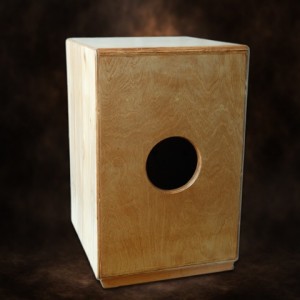 The cajon (the Spanish word for box) has been part of Afro-Peruvian music since the 19th century. This wonderful percussion instrument originated in colonial Peru, when the African slave drums had been forbidden by their masters. Undeterred and driven by the power of music they began using wooden boxes intended to hold fruits or overturned drawers to play their rhythms upon. Later the cajon was officially added to the instrumentation of the vals criollo, or “creole waltz.” It has now become a national emblem for Peruvians, and is an indispensable part of any ensemble that performs the traditional folk music of Peru.
The cajon (the Spanish word for box) has been part of Afro-Peruvian music since the 19th century. This wonderful percussion instrument originated in colonial Peru, when the African slave drums had been forbidden by their masters. Undeterred and driven by the power of music they began using wooden boxes intended to hold fruits or overturned drawers to play their rhythms upon. Later the cajon was officially added to the instrumentation of the vals criollo, or “creole waltz.” It has now become a national emblem for Peruvians, and is an indispensable part of any ensemble that performs the traditional folk music of Peru.
Many stories can also be found in Cuba about how cajons can be used as musical instruments by the marginalized masses. In the early 1960’s, Fidel Castro began getting nervous about the anti-Communist rallies forming in the streets, where masses were being drawn to the beat of drums and the sound of music. As most paranoid dictators do, Fidel “forbid” the playing of music in the streets in order to control the possibility of rebellion. The clever Cubans began to make drums from fruit boxes and other crude materials that one might find on any street. When the police arrived they would only find well behaved citizens sitting atop their fruit boxes and looking for work. Continue reading “The Cajon – A short history”
